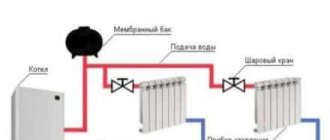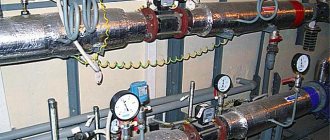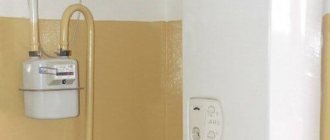The annual increase in service costs forces owners of residential property in multi-apartment buildings to think about how they can avoid paying for central heating services and switch to an alternative - individual heating.
Changing the centralized heating method to installing your own equipment will allow you to independently control temperature indicators and reduce cash costs.
Refusing heating is an action not prohibited by law, but before carrying it out you need to collect the necessary documents and comply with legal formalities.
Is it possible to refuse central heating?
The legislation does not provide a clear answer to this issue. On the one hand, owners are free to choose the range of services they receive from utility and service organizations. On the other hand, the heating plant is part of the common property, which means that unauthorized changes to its design are unacceptable. You will need to obtain permits, their approval, etc. The issue is easier to resolve in the private sector, but it is more difficult legally and technically to complete this step in an apartment building.
The costs of disconnecting and reorganizing the heating network will fall on the shoulders of the subscriber who wishes to disconnect.
What's next
What equipment is best to choose if you are going to install autonomous heating yourself?
Boiler
The optimal choice in terms of efficiency and ease of use is a condensing boiler with a storage water heater.
Why him?
- The condensing circuit is more economical: it increases the boiler efficiency by 9-11% compared to classic gas boilers.
- The storage water heater guarantees a stable hot water temperature. Anyone who has ever used a flow-through gas water heater will understand the meaning of the recommendation: trying to take a shower results in a continuous struggle with the mixer.
Condensing boiler with built-in boiler.
A typical modern boiler is equipped with at least a safety group - an air vent, a pressure gauge and a safety valve. Sometimes its design also includes an expansion tank; in other cases, a membrane tank with a capacity of 10% of the total capacity of the circuit is mounted at any point in the autonomous system.
Pipes
The most practical solution is aluminum-reinforced polypropylene. Reinforcement does not so much increase the strength of the pipes (it is already excessive for an autonomous circuit), but rather reduces thermal expansion.
Batteries
Our choice is sectional aluminum radiators. They combine low cost with decent appearance and excellent heat dissipation (about 200 watts per section). Each radiator is equipped with a valve at the inlet, a throttle or thermal head at the outlet and an air vent in one of the upper plugs.
The photo shows an installed radiator.
How to do this in an apartment building?
Clause “l” of Article 33 of the Rules for the provision of utility services to owners and users of premises in apartment buildings and residential buildings, approved by Decree of the Government of the Russian Federation of May 6, 2011 No. 354, expands the rights of the consumer with contractual provisions. Any contract contains a clause on the possibility of its termination, and you can always find a reason for refusing the services of the heat supply organization.
However, according to industry regulations, disconnection from the heating plant is possible only in relation to the building as a whole, and not its individual part. Therefore, to refuse centralized heating in an apartment building, you will need to use one of the options presented in the table.
| Opt-out option | "Underwater rocks" |
| Obtain the consent of all residents | In a multi-entrance building and with a relatively good quality of service provision, this is unlikely to be possible |
| Go to court to defend your right as an owner | Even with a positive court decision, the heat supply organization can always refer to the lack of technical capabilities to re-equip the heating plant |
Criterias of choice
To successfully select a suitable generator to be used at home or cottage, first determine the following questions:
- Required device power. Determined by a preliminary calculation of the expected load, which is calculated by summing the power of devices (up to 10 or more) that can be connected to the station simultaneously.
- Output voltage (220 or 380V). Determined depending on the requirements for the equipment or instrument that will power the station.
- What electrical appliances will the generator power (the stability of the output parameters matters).
- How often will it be used? When using the device as a backup power source, and when operating for a relatively short period of time, it is better to use a gas generator. A diesel device can also easily cope with this, but for short-term use it is less preferable.
- What resource does the device have? Generators with a short service life (500 operating hours) are lightweight, mobile and have a low price. It is quite suitable if its inclusions are short-lived. When operating the device for more than 7-10 hours, you should choose an engine with a long service life. Typically, for continuous operation of the device for a long time, and when sufficient power is required (more than 10 kW), a diesel generator is installed, which has a long service life, reliability, efficiency, and stable output voltage.
- How important is the noise level during operation of the device.
If a generator is required only to compensate for the lack of light several times a year, then its purchase will not be advisable from the point of view of saving money. In such cases, food in a dacha can be prepared on a camping gas burner, the phone can be charged from the car cigarette lighter, and the food can be stored outside (power outages occur mainly in winter), or you can purchase a cheap inverter option.
Refusal in favor of individual heating in the apartment
From a legal point of view, the procedure for abandoning central heating in favor of an individual heating system is as follows:
- Preparation of documents:
- registration certificate for the apartment;
- ownership documents;
- consent of all persons living in the apartment.
- Selection of an autonomous heating source in accordance with fire safety requirements and operating standards.
- Obtaining a technical opinion on the possibility of carrying out such re-equipment.
- Development of a reconstruction project with calculations confirming the preservation of the functionality of the heating plant without a disconnected subscriber.
- Filling out an application.
- Obtaining permission to carry out work.
What to consider when remodeling related to the transition to autonomous heating
First, you need to make sure that the selected type of heater is not on the list of prohibited ones. Otherwise, the project will definitely not be approved.
Secondly, when installing an individual heating system, you must comply with safety requirements, SNiPs and specifications, and all installed equipment must exactly comply with what is stated in the design documentation. It is better to entrust the preparation of project documentation and installation to a specialized organization.
Even when disconnecting a separate apartment from central utility networks, it is important to disconnect not only the radiators, but also the sun loungers and risers. Otherwise, the room will receive residual thermal energy, for which you will have to pay. If it is possible to cut off only the radiators, an apartment heat meter will help. Payment will subsequently be charged only according to the indications you submit (for residual heating) + ODN.
Declaration of refusal
An application for refusal of services from a heat supply organization as a document does not have a unified form. Climatic conditions in the Russian Federation do not imply a complete abandonment of heat supply; we are usually talking about replacing central heating systems with local units. However, this procedure will already be considered reconstruction and redevelopment, therefore the form of the application is determined by the regulations in force in this area.
Form
The application form was approved by Decree of the Government of the Russian Federation dated April 28, 2005 No. 266 and is a form that contains all information about the object, its owners, attached documents, etc.
How to write correctly?
When making an application, you will need to enter the following information into the form:
- the name of the departmental committee of local authorities authorized to resolve issues of refurbishment of premises;
- personal and contact details of the applicant;
- information about the exact address of the redevelopment object and its owners;
- expected duration and mode of repair work;
- information about living adult household members with a note indicating the presence of notarized consent from each of them;
- listing of attached documents with details (if any) and the number of sheets occupied;
- date of filing and signature of the applicant.
Download application
Since the application form is regulated by federal regulations, the form to fill out is available here.
After downloading, you can print it out and fill it out by hand, or enter the necessary information (except signature) on your computer, and only then print it out.
How to heat water?
Modern boilers solve the problem of heating water for household needs in different ways. There are 2-circuit units that, in parallel with the main function, operate as instantaneous water heaters.
But in order to provide a more or less acceptable supply of hot water, a device of this type must produce at least 25 kW of heat, and for the heating circuit of an average apartment such power will be unreasonably high.
Indirect heating boiler
It is better to install a boiler with an indirect heating boiler. Unlike a “flow tank”, it cannot supply unlimited quantities of hot water, but this is not required for domestic needs.
How to legally refuse?
Refusal of the services of a heat supply organization requires a large amount of preliminary work:
- obtain the consent of neighbors;
- receive a positive opinion from the service organization;
- order a refurbishment project;
- coordinate it with the gas (if necessary) and fire services;
- wait for a favorable response from the redevelopment commission.
The wait for a fully completed package of documents can last for several months, not counting financial costs.
It is impossible to refuse central heating due to long-term non-residence of people in the apartment and for the purpose of recalculation, since heating is a public service that is not turned off even if a debt arises. You will also have to pay for the heat supply of entrances and basements as general house needs (clause 86 and clause 88 of the Rules according to the Decree of the Government of the Russian Federation of May 6, 2011 No. 354).
Selecting a heating device connection diagram
The autonomous heating circuit must be arranged in a horizontal pattern, that is, pipes from device to device will need to be pulled through the entire apartment. With this in mind, the traditional two-pipe system, which is usually located in plain sight, may not be to the liking of many.
Since an apartment heating circuit is usually small, it is quite possible to make it single-pipe - then the pipe can be laid in a hidden way.
On short circuits, the disadvantages of a single-pipe circuit are almost invisible. The ideal option is a collector or beam circuit. It allows you to lay pipes in a hidden way, while the heat is distributed evenly between the radiators.
Certificate of refusal
Until 2011, after re-equipping the heating system, it was necessary to submit an act of abandonment of central heating, drawn up in the presence of the owner, management company and a representative of the resource supply organization. However, after the approval by the Government of the Russian Federation of May 6, 2011 No. 354 of the Rules for the provision of utility services to owners and users of premises in apartment buildings and residential buildings, heating fees are not recalculated.
Charges for general house needs and heating of apartments occur at a single rate, regardless of whether the radiators are operating in a given room or not. The only way out in such a situation to reduce payments (it will not be possible to refuse completely) is to install an individual heat meter at the heating plant with subsequent transfer of zero readings to the Unified Center.
Thus, abandoning central heating is a time-consuming procedure complicated by bureaucratic delays. In an apartment building, this option may not be feasible at all, since it will require consent from all residents of the building. And it will not be possible to refuse heat supply services in order to save utility bills.
What other issues need to be addressed?
Obtaining approval to turn off the centralized heating supply in your own home is not an easy task. It will not be possible to resolve this issue in a few days.
The procedure will take some time, since the entire system, together with the boiler, must comply with established safety standards:
- You need to purchase a boiler to switch to an alternative heat supply.
- Buy a circulation pump or use a modern boiler.
A hermetically sealed boiler must have equipment that ensures complete safety. The pressure cannot increase more than 1 MPa, and the temperature of the liquid in the circuit cannot exceed 95˚C. You can choose any radiators; aluminum ones are more often installed.
For pipe routing, the layout features of a residential apartment are taken into account. You can use a beam circuit or a single-pipe circuit.
Where to call if the heating is turned off - hotline for complaints
You should initially call about heating to the office of the management company and the district emergency service. Sometimes the service organization has no information that the heating supply to the house has been suspended. In other situations, management company employees do not respond to complaints.
In this case, you need to call special hotlines about heating.
The following services operate in Moscow and Moscow Region to regulate the situation with heat supply:
Table 1.
| Contacts | Organization |
| +74955395353 | 24-hour telephone service regarding housing issues. Unified dispatch center for utilities. |
| +74955395959 | United Energy Company |
| +74956809861 | Housing and communal services |
| +74956817367 | Moscow Department of Housing and Communal Services. Directly supervises issues of water resources, sewerage and heating. |
| +74956810549 | The second number of the control room of the Ministry of Housing and Communal Services. You should also call here if the heating is turned off. |
| +74956202760 | Emergency service for road accidents and repair of pipelines located under the road surface. |
| +74957758770 | City center of the capital. |
| +74997633434 | Vodokanal stronghold |
| +74956578703 | An organization that controls the operation of drains. |
A complaint can be submitted remotely through the websites of local municipalities: Table 2.
| Department | Link to the official portal |
| Moscow administration | www.mos.ru/dgkh |
| Electronic reception of the mayor | www.mos.ru/feedback/individual |
| MOEK | www.moek.ru |
| Public services | www.gosuslugi.ru |
| "Moscow is our city" | https://gorod.mos.ru/ |
| GZHI | https://www.mos.ru/feedback/individual/?department=20197090 |
| Ministry of Housing and Communal Services for Moscow Region | https://mgkh.mosreg.ru |
| Government of Moscow region | https://mosreg.ru |
Reasons for turning off the boiler
First you need to figure out what are the reasons for turning off the boiler in the summer and whether it needs to be done at all. They do this for reasons related to gas saving. But it seems so only at first glance: in fact, frequent boiler shutdowns affect the condition.
This increases wear on the equipment and can cause breakdowns:
- Firstly, the longer the system is idle in the cold, the lower the temperature of the coolant and the harder it will be to heat up when the boiler is ignited. In this case, fuel consumption will be significant.
- Secondly, the temperature of the heat exchanger decreases. When reheated, drops of water will accumulate on its surface. This is condensation, which can cause destruction and corrosion of the heat exchanger.
- Thirdly, drops of water also settle on the burner. This significantly reduces its operating efficiency and, as a result, increases fuel consumption.
Corrosion of the main components of the boiler structure requires their replacement in most cases. The possibility of repair by soldering is unlikely. Correct smooth startup of equipment after long periods of inactivity will help reduce the risk of such problems. Most boilers have special operating modes
If available, it is important to be able to turn them on correctly on various types of automation and units of different brands
Important! To save fuel, you can leave the boiler on during the summer. There are many ways to save
One of them is the use of modulating burners. When deciding whether or not to turn off the heating system in the summer, you need to evaluate the possible risk and the amount of gas saved.
Considerations and possible consequences
Please note
: As a rule, a complaint is considered within 10 to 30 business days from the date of its receipt. Based on the results of the analysis of the application, a higher authority may oblige the responsible organization to take measures to restore the heat supply, setting an acceptable time frame.
Also, the organization, due to whose actions the heat supply was stopped, is obliged to recalculate payments. Charges for the period of absence of heating or its limited supply cannot be considered legal.
As a rule, in order to return funds misappropriated by the company, residents must independently apply for a recalculation of funds for the entire time when the premises were not heated, contrary to legal norms.
Comments Showing 0 of 0
Heating season schedule in 2020
Period when heating will be turned on in 2022:
- Moscow - the heating season begins on September 25.
- St. Petersburg - start of inclusion from September 16 to October 1.
- Tver - starting from September 23, heating will be provided in public buildings; starting from September 26, heating will be provided to residential buildings.
- Vladimir - from September 23.
- Yaroslavl - starts on September 23-24 and the last inclusions will take place on October 1.
The table provides information when the heating was turned off in 2020:
| City name | Date of planned system shutdown |
| Moscow | April 30 - May 2 |
| Saint Petersburg | April 27 |
| Tver | April 29 |
| Vladimir | April 23 |
| Yaroslavl | April 27 |
| Voronezh | April 19 |
| Ufa | April 30 |











